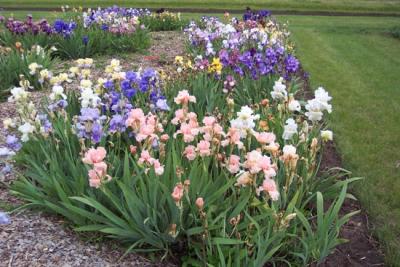June Gardening Tips and Tasks
Thanks to University of Maryland College of Agricultural and Natural Resources for sharing this informative article about gardening.

Outdoor Yard and Gardening Tips
- Cut iris flower stalks down to the crown when they are finished blooming. Leave the foliage alone. If your iris are over-crowded after flowering lift and divide them. Check rhizomes for iris borer.
- Practice IPM(Integrated Pest Management)in your landscape. Do not spray your trees and shrubs preventively. This kills the predators and parasitoids that are helping to keep destructive pests under control.
- Water newly planted trees and shrubs until they become established (for about 2 years), especially in the summer and fall. Water deeply by allowing the water to soak into the soil directly underneath and around the root ball. Check the depth of water penetration into the soil by digging a small hole after watering. It should be moist about 6 inches down. A 2-3 inch layer of mulch is helpful. Keep mulch away from the trunk or stem.
Plant diseases
- Bagworm larvae are hatching out this month and constructing new bags. Look for the little bags moving around on evergreen trees and shrubs and be prepared to spray infested trees with the microbial insecticide, B.t. between now and mid-July.
- Apple scab and a number of rust diseases (cedar-apple, cedar-quince, cedar-hawthorn, Japanese apple, and pear trellis rust) are destructive diseases of crabapple in the landscape. They cause severe leaf defoliation by mid-summer if not treated. The best defense is replacing disease prone cultivars with resistant selections available at garden centers.

- Perpetual spinach, Malabar spinach, amaranth, sweet potato leaves, ‘Vitamin Green’, ‘Tokyo Bekana’ and Swiss chard are good heat tolerant salad greens for Maryland.
- Flea beetles are a serious pest of eggplant and also affect potato, tomato and members of the cabbage family. Floating row covers (video below) are an effective means of management but should be removed when plants flower to allow for cross-pollination by bumblebees. Spraying plants with “Surround” (kaolin clay) creates a white particle film that can minimize flea beetle feeding. You can also control flea beetles with “neem”, a botanical insecticide.
- Young tomato plants may be exhibiting symptoms of various leaf spot diseases such as septoria and early blight. Remove badly infected lower leaves, keep a thick organic mulch around plants and avoid overhead watering while gardening.
- “June drop” of excessive fruits (especially peaches) is a natural thinning phenomenon and is more pronounced where no hand thinning has occurred. Hand thin the fruits on plum, peach, apple and pear trees, leaving space (the width of one fruit) between remaining fruits. Disease and insect problems, environmental stress, and lack of pollination or fertilization can also cause fruit drop. Pick up and throw out all dropped fruits.
Indoor Plant and Insect Tips

Spider mite webbing
- Monitor houseplants kept indoors for mealybug, spider mites, aphids, whitefly, and scale. If houseplant pests are a problem consider spraying with a labeled horticultural oil or insecticidal soap. If possible, move the plants outside before spraying and when dry, move them back indoors. Discard heavily infested plants.
- Pantry pests, like Indian meal moths, grain beetles, cigarette beetles, and carpet beetles may be found around windows trying to get out of your home. These pests can be swept up or vacuumed. No chemical controls are recommended.





Recent Comments